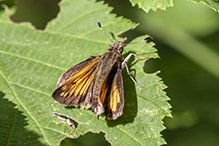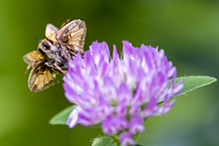Hobomok skipper
(Lon hobomok)
Conservation • Description • Habitat • Ecology • Distribution • Taxonomy
|
|
||||||||||||||
Description |
Hobomok skipper is a common, medium-sized, grass skipper. It occurs in the United States from Maine to Florida, west to Montana and New Mexico. It is most common and sometimes abundant in the Northeast and the Upper Midwest. It is uncommon in the south except along the Appalachian Mountains. Adults are active from mid-May to late June, sometimes into early to mid-July. They are found in a wide variety of habitats, including in fields, meadows, roadsides, stream sides, and parks, at the edges of bogs, and at the edges and openings of deciduous woodlands and shrub lands. They feed on the nectar of many species of flowers, including blackberry, common viper’s bugloss, dandelion, downy phlox, henbit deadnettle, honeysuckle, Labrador tea, lilac, milkweed, orange hawkweed, red clover, vetch, and wild strawberry. The larvae feed on various grasses, including panic grasses and bluegrasses. Adults have a 1″ to 1⅝″ (25 to 43 mm) wingspan. The forewings are relatively squared at the tip. The hindwings are broadly rounded. The upper sides of both wings are yellowish orange with a broad, dark brown band on the outer margin. On the forewing, the leading edge (costal margin) also has a broad, dark brown band. The black cell end bar is relatively low on the wing. On the hindwing, there is no dark band on the costal margin. The orange patch is crossed with dark brown veins. The undersides of both hindwings have large pale patches. The dark band on the outer margin is brown to purplish brown. The hindwing has an extensive brown patch at the base. Females have two color forms. The “normal” form is as described above. In New England, 25% to 50% of females are the “Pocahontas” form. The Pocahontas form is all dark purplish black. On the upper side there are several tiny white dots, and there is a pale cell spot. On the underside, there are a few creamy white spots. Toward the front of abdominal segments two through eight (A2 to A8) there is a subtle brown spot in the subdorsal area. The caterpillar is about 1″ long and tan to orangish brown with blurry dark spots. The thorax and abdomen are densely covered with velvety hairs. The hairs are short, but they are longer than on other grass skippers. There is a narrow stripe in the middle (middorsal stripe) and another above the breathing pores (supraspiracular stripe). The middorsal stripe is medium dark but distinct, the supraspiracular stripe is indistinct, barely darker than the background color. The head is reddish brown and unmarked. Behind the head, the collar is mostly light brown with a thin dark brown ring at the rear. |
Size |
Wingspan: 1″ to 1⅝″ (25 to 43 mm) |
Similar Species |
Habitat |
Fields, meadows, roadsides, stream sides, parks, the edges of bogs, the edges and openings of deciduous woodlands and shrub lands, |
Ecology |
Season |
One generation per year: late May to late June |
Behavior |
The forewings and hindwings are held spread at different angles when at rest. |
Life Cycle |
|
Larva Hosts |
Grasses, including panic grasses and bluegrasses. |
Adult Food |
Nectar from many species of flowers, including blackberry, common viper’s bugloss, dandelion, downy phlox, henbit deadnettle, honeysuckle, Labrador tea, lilac, milkweed, orange hawkweed, red clover, vetch, and wild strawberry |
Distribution |
||
|
Sources 4, 7, 21, 24, 27, 29, 30, 71, 75, 82, 83. Biodiversity occurrence data published by: Minnesota Biodiversity Atlas (accessed through the Minnesota Biodiversity Atlas Portal, bellatlas.umn.edu, 6/15/2024). Gatrelle, R.R. 2002. A review of Poanes hobomok (Hesperiidae: Hesperiinae) with the description of a new subspecies from the southern Appalachians. The Taxonomic Report of the International Lepidoptera Survey, vol. 3(8): 1-8. |
|
| 8/15/2024 | ||
Occurrence |
||
Common, sometimes abundant |
||
Taxonomy |
|
Order |
|
Superfamily |
Papilionoidea (Butterflies) |
Family |
Hesperiidae (Skippers) |
Subfamily |
Hesperiinae (Grass Skippers) |
Tribe |
Hesperiini |
Subtribe |
Hesperiina (Branded Grass Skippers) |
Genus |
Lon |
Superfamily Genus |
|
Subordinate Taxa |
|
Hobomok skipper (Lon hobomok hobomok) Hobomok skipper (Lon hobomok monofacies) Hobomok skipper (Lon hobomok wetona) |
|
Synonyms |
|
Poanes hobomok |
|
Common Names |
|
Hobomok skipper northern dimorphic skipper |
|
Glossary
Apiculus
A thin hooked or pointed extension at the ends of each antennae just beyond the club of all skippers except skipperlings (subfamily Heteropterinae).
Costal margin
The leading edge of the forewing of insects.
Instar
The developmental stage of arthropods between each molt; in insects, the developmental stage of the larvae or nymph.
Spiracle
A small opening on the surface of an insect or arachnid through which it breathes.
Stigma
In plants, the portion of the female part of the flower that is receptive to pollen. In Lepidoptera, an area of specialized scent scales on the forewing of some skippers, hairstreaks, and moths. In other insects, a thickened, dark, or opaque cell on the leading edge of the wing.
Visitor Photos |
||
Share your photo of this insect. |
||
This button not working for you? |
||
Luciearl |
||
 |
||
 |
 |
|
 |
 |
|
Babette Kis |
||
 |
 |
|
Poanes hobomok Hobomok skipper Poanes hobomok, Hobomok skipper, on grass at Barnes Prairie, Racine Co., Wisconsin. Photos taken May 31, 2021. |
It's often found in grassy areas, including old fields, roadsides, and in my photos, a tallgrass prairie. |
|
Scott Leddy |
 |
MinnesotaSeasons.com Photos |
||
 |
 |
|
Wing upper side |
Wing upper side |
|
 |
 |
|
Wing underside |
||
|
||
|
||
Wing upper side |
|
|
 |
 |
|
Wing underside |
Wing underside |

Slideshows |
Hobomok Skippers |

|
About
Lon hobomok larvaL bugguide.net/node/view/335371/bgimage |
Lon hobomok (Hobomok Skipper) |

|

Visitor Videos |
||
Share your video of this insect. |
||
This button not working for you? |
||
|
Other Videos |
||
Hobomok Skipper Pollinating Milk Thistle - June 15, 2013 |
About
Published on Jun 17, 2013 Hobomok Skipper (Lon hobomok) Pollinating Milk Thistle (Silybum marianum), Butterfly Garden, Gagnon Wildlife Habitat, Pottersville, Somerset, Massachusetts, Saturday morning, June 15, 2013, 11:12 AM - Canon PowerShot SX50 HS MVI_11326; 1:31 min. |

Visitor Sightings |
||
Report a sighting of this insect. |
||
This button not working for you? |
||
Luciearl |
Location: Fairview Twp. |
 |
Luciearl |
Location: Lake Shore |
 |
| Luciearl 6/2/2018 |
Location: Cass County |
 |
Crystal Boyd |
Location: Uncas Dunes SNA |
MinnesotaSeasons.com Sightings |
||

Created: 3/25/2014 Last Updated: © MinnesotaSeasons.com. All rights reserved. |

